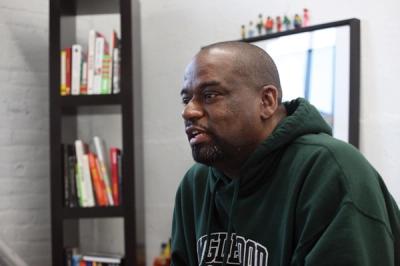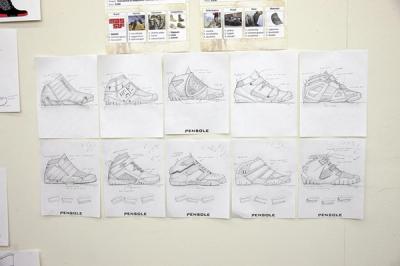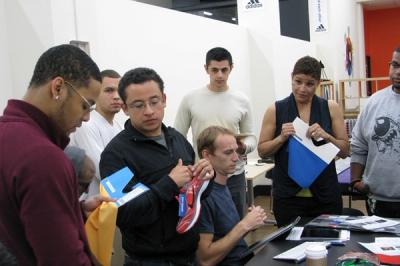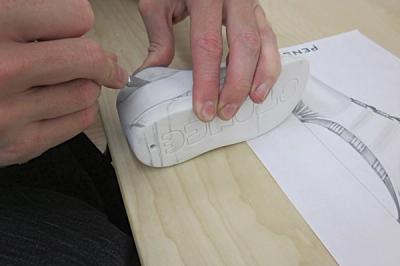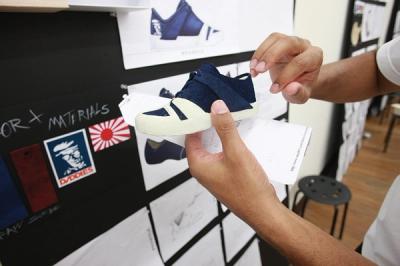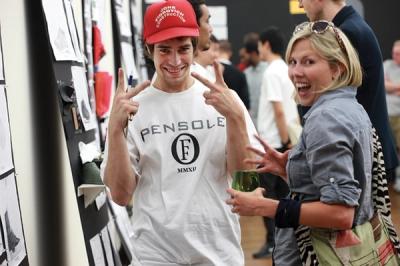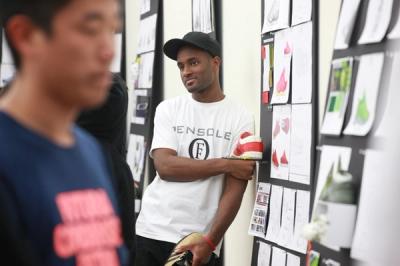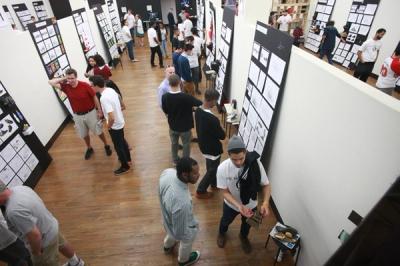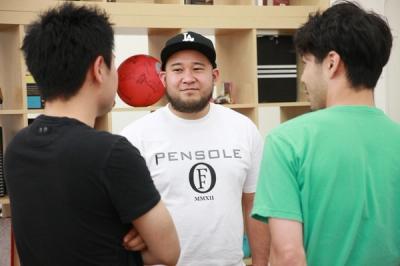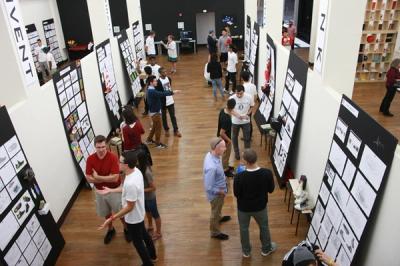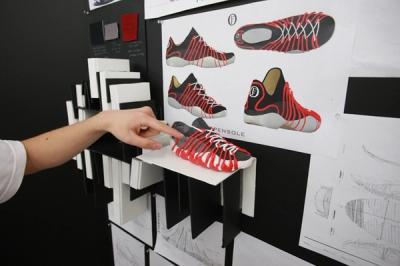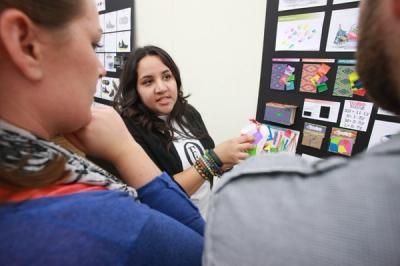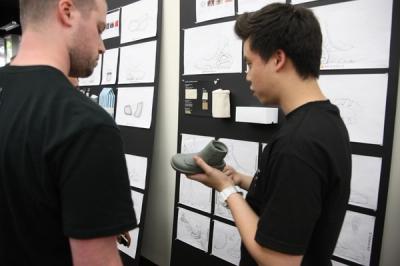Pensole: Bootcamp For Sneaker Designers
Becoming a sneaker designer is an ambition shared by many of our readers. Turning a natural talent with a Sharpie pen into a professional career is not just daunting, it seems to be an impossible transition. We know because we’ve read your emails, seen your sketch books and heard your pleas for help. How the hell do you get your foot (literally) in the door?
D’Wayne Edwards knows. Back in the late 80s, he dreamed big from his childhood home in Inglewood, Los Angeles. Eventually he scored a job at LA Gear as a file clerk, pestering the owner so hard they finally gave him his first break. Fast-forward a few years and D’Wayne had moved on up to Nike and then Jordan, where he would have the rare honour of designing for MJ himself.
With over 500 shoes and 30 patents to his name, D’Wayne could have been content with his career. Reflecting on his experiences and how far he’d come from Inglewood, he resolved to leave an even greater impression on the industry than his design work alone. Pensole was his personal response. The first of its kind in the US, Pensole has since grown into a fully-fledged sneaker design academy where students are drilled in intensive bursts. It’s a boot-camp environment taught by the best brains in the footwear business. We recently caught up with D’Wayne to see how PENSOLE is helping the next generation make it to the big league.
Did you really set out to be a sneaker designer or was it an accidental career choice?
No accident at all! I grew up in Inglewood, which is a rough part of Los Angeles. I grew up a sneakerhead before anyone knew what that was. When I was in high school I customised my white-on-white Air Force 1s to match my basketball uniform. I was Nike iD back in 1986! Man, all through high school I wanted to work at Foot Locker to support my sneaker habit, but they did not hire me. Little did they know they would be buying my shoes years later. While looking for another job, I saw an ad for a Reebok design competition. I entered and won, but I was only 17 and they were expecting someone older and told me to come back and see them when I’d finished college. I asked them what college I could go to that would help me become a footwear designer and they didn’t know. This is when I started thinking about creating my own design school one day. I was disappointed when Reebok passed on me, but that also motivated me to prove to them that they had made a mistake.
Well it was Reebok’s loss, because not long after that you started at LA Gear, right? What was that like and what the hell was going on over there? The ad with Heather Locklear in those acid wash denim pants still breaks my heart!
Heather was cool but I was more into Vanity (Prince’s protégé and the lead singer of girl group Vanity 6). She could fill out those denim pants much better than Heather. I actually started at LA Gear as a file clerk in the finance department. I was not hired as a designer until I submitted 180 different designs, one every day for six months. The owner of the company Robert Greenberg hired me shortly after my 19th birthday. Sounds crazy, right? To this day I still can’t believe it but there I was, a young black kid from Inglewood living my dream as the youngest professional footwear designer in the industry.
Robert saw more in me than I saw in myself and he put me to work day one. It was an awesome experience because I was introduced to two key philosophies that have impacted my entire career both as a designer and a teacher. The first was ‘Learn by doing’. Since I had no formal training or education in design, I learned everything on the job. It was great because every day was like I was in school but I got paid for it. I found learning this way was faster and I retained more knowledge.
The second was ‘Approaching design like an actor does a movie role’. I grew up in Inglewood, which is not the LA Gear customer or lifestyle, so I had to understand that I was not designing for me. This was crucial to my development as a designer because I had to learn how to become the consumer. Doing this allowed me to design over 500 different styles over the course of my career.
From there you moved to Nike and Jordan. I’m sure that would be every budding sneaker designer’s dream, as well as an intimidating environment. How would you counsel young kids on making their mark at the biggest brand?
Yeah, since I was in high school my dream was to be a Nike designer but I never thought I would ever design for Jordan. Michael Jordan? Michael ‘Air’ Jordan! Even as a die-hard Lakers fan, I admired him and the shoes so much I just never considered it something I would ever do. Now that I look back on it, it was a valuable lesson that I talk to students about today.That lesson is to dream big!
It was not until I started at Nike and I was working one floor below the Jordan brand that the thought came to mind. I still remember sneaking up to the Jordan floor just to smell the air up there! One day I was asked to design a Jordan boot, which led to designing sneakers, which led to working permanently in Jordan. Within months I was presenting a shoe I designed to MJ himself. Talk about pressure!
MJ sensed I was nervous, and true to his form on the court he started drilling me with questions about my design. I was firing back answers because I did my research and was confident with my work. This is another philosophy I teach today, which is ‘Nobody should know more about your design or your research than you do’. Whatever you choose as your inspiration for your design, you need to become an expert in what inspired you. In this case my inspiration was MJ’s newest toy, an Aston Martin Vanquish.
Passing MJ’s test must have been a proud moment. Other than that, what was your biggest success? Any other good stories? C’mon!
Honestly, I don’t think about ‘my success’ or the idea of being successful. I believe when you get caught up in the hype is when you lose your hunger and drive. I don’t like talking about what I have done because I am so focused on learning and being better than I was the day before. I guess my definition of success is progress.
One of my favorite Jordan stories was the time I flew to Vegas for a few hours to deliver Roy Jones Jr. his Jordan boxing shoes the night before his history-making Heavyweight title fight. Designing a shoe for a pro athlete is an amazing experience because millions of people get to see your design on TV. It’s also a lot of pressure, and even more if it is a boxer because his footwork is key to his success. So, I showed up to Roy’s suite with two pairs, one pair for him to wear during the fight and the other pair to sign for me. It was a great meeting because he loved the shoes and I was able to see how an elite athlete prepares for the biggest moment of their career. Roy is not like other athletes though, he has supreme confidence and even signed my shoe as ‘The new Heavyweight champion’.
A few minutes later I realised it was time for me to leave so I could catch my flight back to Portland. He said, ‘Where are you going?’ I said, ‘I have to catch my flight’. He said, ‘You’re not staying for the fight?’. I said, ‘No, I just came up to drop off your shoes’. He said, ‘Do you want to go to the fight?’. There I was the next night watching him win the Heavyweight title in shoes I designed.
The industry has changed a lot since you got into the game. What’s the biggest shift in sneaker design you’ve noticed over the years?
Design and technology has got better but I feel it’s getting lost by the quest to create what I call ‘manufactured storytelling’. Some companies are trying too hard to tell stories to appeal to consumers.
It’s almost like when there is a blockbuster movie being released and they pay more attention to all of the advertising, merchandising and promotion and they forget to make a good movie. I know I am an old head in this industry, but what I appreciated about sneakers back in the day was that they were designed with a focus to make the athlete better without the thought of ‘Does it look good with jeans?’. Today it seems some companies want the shoe to just have a ‘cool’ story instead of making a good design and letting their consumers decide the story they want to tell with it.
I could go on and on, but instead of complaining I decided to start a school that will at least give the next generation of designers the tools to respect the culture and learn the art of design, with the goal of making good sneakers.
Good point. That seems a great motivation to start PENSOLE. What were some other reasons you thought this school was necessary and how have you found the transition from designer to teacher after leaving Nike?
Wait, wait, don’t write me off yet. I am not ready to give up the title of designer! I would say I am still a designer learning to become a teacher. In my opinion you have to earn the title of designer, and you must continue to improve to keep that title. I feel the same way about being a teacher, but instead of designing a product I am sharing knowledge to inspire future leaders who just happen to have aspirations of being a designer.
After many years mentoring several aspiring high school and college students that are now Nike and Jordan designers, I was constantly reminded of the gift Robert Greenberg gave me back when I was 19. Investing time into a person can make a much larger impact on this industry than designing a new shoe. Shoes come and go but impacting a life is generational. One day in an interview I was asked what was the one shoe over the course of my career I was most proud of. After thinking about it, I realised the thing I was most proud of in my career was not a shoe. It was the people I mentored. That was the moment I decided I wanted to leave this industry better than when I entered it. I decided to leave Nike and revisit the idea I had as a 17-year old kid and start my own footwear design school. I named it PENSOLE as a tribute to the instrument that designed my life: a pencil.
I read PENSOLE is like boot camp. Are we talking chin-ups and 6am alarm calls?
Hmmm, close! We don’t just teach design. We teach simple life lessons such as the importance of being on time. Class starts at 9am but 8:45am is on-time, and for every minute a student is late they have to do five push-ups. The most push-ups a student has done is a little over 200. We do this because in the real world being late can get you fired! Being late is one of several bad choices people make and if you are saying you are a PENSOLE student I expect more from you and employers will as well.
A typical class day is about 12 to 14 hours long, which helps establish the work ethic you will need to succeed in the real world. All PENSOLE students learn quickly that ‘Actions speak louder than words’. If you ask the majority of my students about their experience at PENSOLE, I am confident they will say they had fun, learned a lot, met some amazing people and developed new friendships. But if I had to sum up PENSOLE I would say it’s a master class that prepares students for the next step in their design career.
Shoe designing is a complex skill-set to learn, how comprehensive is the curriculum?
Yes, it is more difficult than people think. It’s not as easy as Nike iD. At PENSOLE we don’t ‘draw’ shoes, we ‘design’ shoes. We teach students to be responsible for every stitch because, in my opinion, when a designer designs a shoe they are giving birth to their new creation. With this in mind, why would you let someone else decide what your creation should look like?
We want our students to understand all aspects of footwear design from its history to the culture associated with it, from the language to the business and consumer side of it. We also emphasise professional skills such as portfolio development, personal branding, time management and networking.
2012 was an amazing year for PENSOLE but we have some pretty cool plans for 2013 that will get us closer to my goal of making PENSOLE the premier design school worldwide. The classes will be longer and harder and we will be adding Italian shoemaking and sample development to the curriculum. Some of our plans include Sneaker Freaker too, which we will announce at a later date…
We’re looking forward to that. One thing I’m sure our readers want to know is whether the course really prepares them for a job?
Yes it does, if they listen, take notes and revisit those notes over and over after the classes. PENSOLE is not a magical place that people come and after four to six weeks they become a designer. Design is like sports or any activity you want to learn and get better at. The more you respect and practice the craft, the better you get at it.
I would say I try to help aspiring designers understand that getting a job is not all about your rendering skills. Your physical talent counts for about a quarter, half of it is how you think and the last quarter is who you are as a person – your work ethic, curiosity, drive, personality, communication skills etc. Man, I can go on and on about that…
I have had some students come to PENSOLE twice and a few three times. I can say that the majority who have come more than once are working professionally, but I don’t want anyone to come to PENSOLE and immediately expect to get a job. However, in a little over two years there are over 35 former PENSOLE students working at major footwear companies such as Nike, Jordan, New Balance, Under Armor and adidas, either as a full-time employee, contract employee or intern. This type of success in such a short time reassures me that PENSOLE is making an impact on the footwear industry, and the ‘footernity’ of designers will some day carry on the legacy we are trying to create. The other great thing about PENSOLE is all of the instructors besides me are working at some of the top companies in the industry, which means they are teaching you what it takes to get a job, and you are learning from a direct reflection of who you want to be.
Is there anywhere else kids can learn all this stuff aside from PENSOLE?
Not all in one place. There are some amazing design schools out there that teach their students at a high level, but I would say one of the things that makes PENSOLE different is I put students in the real world of what it is like to work at a company. I am bringing my 23 years of experience, and my other instructors combined bring over 100 years of experience, to give our students an education they cannot get anywhere else in the one place. We are still developing the academy and are constantly improving the curriculum and updating the facilities. Give me another year and our facilities will rival many of the top design schools and footwear companies nationwide.
